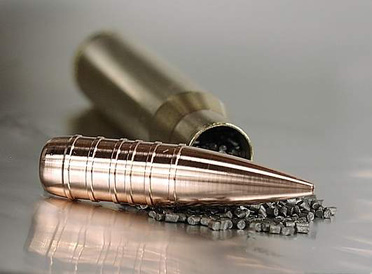

 The Accurate Reloading Forums
The Accurate Reloading Forums  THE ACCURATE RELOADING.COM FORUMS
THE ACCURATE RELOADING.COM FORUMS  Guns, Politics, Gunsmithing & Reloading
Guns, Politics, Gunsmithing & Reloading  Bullet Making
Bullet Making  Re: Paper Patching Jacketed Bullets
Re: Paper Patching Jacketed BulletsGo  | New  | Find  | Notify  | Tools  | Reply  |  |
| one of us |
Onion skin is available all over. Office supplies, drug stores, take your pick. You want the thinest you can get. Bank note paper, thick cotton based paper and such are not as good. You want it to be cut into strips by the lands and grooves. If it unrolls in one piece accuracy will suffer. A bullet that it right at land diameter is about right. .450 for a 45-70 is an example. Two layers of onionskin will bring up about ten thousands. That will be about right. Use 50/50 bee's wax and vaseline for the lube. | ||
|
| one of us |
HP, there is no danger of fire with a paper patched bullet either. Never had a smoldering patch, much less a burning one. Wad material makes a big difference here. Generally one uses a plastic or hard fiber wad under the bullet. These will not smolder nor will they let the bullet's patch get hit by hot gas. I've heard of putting just about everything on a bullet from teflon tape to mailing labels and even masking tape. To each his own, but regular paper patches are what I do. Brent | |||
|
| one of us |
Brent, I've had your site in my favorites for some time now, and appreciate the effort you put into it. I've not tried patching jacketed bullets but read an article sometime back that reported some success, although it was not a ringing endorsement. I think lead is the better approach simply because bullet diameter and patch thickness are critical for best results. That it works at all with jacketed bullets is not surprising since bullets less than bore diameter are used for patching black powder rounds. Whatever you use, the salient point is to fill the remaining space with paper. I do not find it tedious or slow, and can prep 100 bullets/ hour when I'm feeling frisky. As mentioned above, "The Paper Jacket" is a good primer, so is Brent's web site. A few pointers and thoughts: 1. PP bullets work well in handguns, at least Ruger .44 Mags. 2. Mathews says that 2000 fps with pure lead, and 3000 fps with hard alloy bullets is achievable and I believe. I have done pure lead at 1700 fps in a 45-70(510 gr) and 1535 fps in a 44 mag(300 gr) with sub MOA acccuracy. 2400 fps(chronographed) with a hard RB out of the .44 but accuracy was...good enough to hit the target at 25 yds.  3. Fine accuracy with PP requires obturation of the bullet, as least with lead bullets. 4. Dry patch is doable but it's a pain in the ass. Wet is far better. 5. Unlubed PP bullets are excellent for polishing a grey bore. About a half dozen shots, moderate load. Additionally, continued used of unlubed PP bullets is unwise for obvious reasons. The 50/50 Vaseline/Beeswax lube is excellent for smokeless and Black in my experience, though my excursions with black are limited. 6. DON'T YOU EVER, EVER, EVER, use glossy paper. It contains kaolin whick is a clay material and it is highly abrasive. Ditto any paper that is unnaturally opaque. Onion skin, and tracing paper top my go to list, others may work as well. Typically, it will shrink after drying. Slightly. 7. The object is to shoot. Don't stress too much about the quality of your patches at first. Load 'em and shoot. It is a quickly acquired skill, the more you shoot, the quicker you acquire. 8. My loads use flat base bullets. Others find success with cupped base. I shoot smokeless, they use black. Go figure. Don't be bashful about experimenting. By the time I'd fired my first 300 PP bullets I'd gone through 5 evolutions with wrapping technique. 9. Use card wads. Easy to make with a chamfered case mouth and notebook card stock. And a hammer. And a piece of plywood to pound on. One good whack does the job. How many whacks can you make in one hour?   10. I need a cup of coffee. If you're interested in the art, visit Brent's site and/or read Mathews' book. After you have done your homework, if you have questions shoot me an email, I'll help if I can. Paper Patch - The original controlled expansion bullet. p.s. You can do smaller than .30 cal. PP .22 cf ammo was once available commercially. p.p.s. If you try the jacketed PP thing, remember that your rifle needs to have a twist that will stabilize the patched bullet as if fired from it's intended bore. As an example, an 80 gr. .224 BTHP can probably be patched an fired from a 6mm bore. It will NOT stabilize with a 1:10 or 1:12 twist. Your 6mm will need a 1:7 or 1:8 twist for this to work. www.Illstop.now | |||
|
one of us |
At times when commercial bullets for my 404 Jeff are not available, I have resorted to PP .410 jacketed bullets up to .425 with great success. Recently I draw up a new PP to use .308 bullets in an 8mm Mauser. Has anyone else tried PP jacketed bullets? | |||
|
one of us |
I had Hoch build a .451 diameter 500 grain bullet for my Alex. Henry muzzleloader replica. I have paper patched the bullet with tracing paper for my 458, and I have shot some very nice groups with full power loads using nothing but wheel weight material. I am anxious to try the bullet on game. | |||
|
| One of Us |
Bad Ass, I think paper patching is even more of a lost art that bullet casting. I'm in awe of you guys who are clever enough to do it. I was always too lazy/cowardly to even try and just stuck with cast. I hope you guys will share some information about the subject for the bullet making crowd. PP is something they should teach in school.  | |||
|
one of us |
I used to paper patch cast .357 bullets to .368 diameter for use in my O/U 9,3x74R rifle. These were training rounds backed up with 2400 and results at 50 m were good. Paper patching is a bit of a hassle as paper weight and patch size have to be exact, patches are wound on wet and shrink to size after drying. Lots of experimentation before you're done. Then only, you can build a pattern which makes cutting patches easy. BTW, do you know that legal ballistic experts frown upon this practice which could make their life impossible. As a matter of fact, it is entirely possible to load up accurate rifle ammo with patched smaller caliber pistol bullets. To add a little spice, imagine a recovered and rifle marked bullet from someone else's pistol, see what I mean... | |||
|
one of us |
I assume from the replies that nobody PP's JACKETED bullets. My method is firstly to roll the jacketed bullet between two mill bastard files 2-3 times. This will add a fine knurling to the copper surface. Owning a computer drafting business, I use the electronic drafting software to caculate and draw an outline two wraps of paper around the bullet to finish with flush edges. The paper (bank 60gms)is rolled on dry and twisted around the back of the bullet. Then I apply a thin coat of my BPCR lube to seal against moisture. By applying the patch dry, I can achieve a tight wrap without tearing the paper. Accuracy has been excellent with velocity and accuracy as good as straight jacketed. The method was born of necessity as I wanted to shoot good 30cal match bullets in the 8mm Mauser and none were available from my local shop. | |||
|
| One of Us |
Badass, I apologize for my haste and faulty response to your original post. My dim mind did not grasp until now that you were paper patching JACKETED BULLETS.  I have never even heard of this being done.  I don't think you'll get many replies, my friend, mostly because you are blazing a new trail. You're doing some interesting work here.  | |||
|
one of us |
I've never patched jacketed bullets but the process is indeed the same. I experimented years ago, following suit to an article by Ross Seyfried. Can you wrap tight enough with dry paper ? I followed the author's recommendation and used wet patches, twisting the tail now and then while the patch dries and when shrinked, cut off the tail. True, while satisfactory - the patch is intimately "wet molded" to the bullet contour, one tears up a patch now and then. The "shrink" part is also what demands the most experimentation to find the right size patch that shrinks "edge to edge". Once found, I made an alu pattern to cut patches. If performing the same, dry wrapping would save most of the hassle. | |||
|
one of us |
Bad Ass, you've really hit on something useful. I looked around a little for the post a while back by the guy who was looking for some odd bullet size like .316" but "wasn't going to fool with cast bullets," to point him here. Bet he could patch up some .308s (if he'd "fool" with that) and get good results. I'm anticipating getting some Mosin-Nagants in the near future, which are notorious for having groove diameters in that range, and I may do just that when I'm not shooting cheapo Soviet-bloc surplus ammo. | |||
|
| one of us |
Sayfried (sp? sorry if I got it wrong) did this with 500 gr. .458 bullets in a .470, I believe. I probably still have the article around someplace. I don't remember any problems. I will see if I can find the article. What about paper patching revolver bullets? C.G.B. | |||
|
| One of Us |
It sounds to me that really all a shooter is doing with paper patching is just creating a "poor mans sabot?" Not true? Sabot projectiles certainly work but I don't think are extremely accurate. However, the way Bad Ass is applying this "paper sabot" it seems he is making it such an integral part of the bullet that accuracy may be ENHANCED, rather than depreciated.  What's to keep someone from buying some .264 bullets and patching them to use in a .270? What all could be gained by such a crazy thing? Velocity? Broader bullet selection? Improved sectional density? etc? BA has uncorked a complicated but highly interesting topic on us. I wish the thoughts kicked around here were getting broader readership by our fellow hunters and not just us nutty bullet makers. | |||
|
one of us |
Properly done, the PP is a poor man's jacketed bullet. The PP bullet was the interum between cast and jacketed bullets. | |||
|
| one of us |
Well, It could even have another advantage, you know - even for the lazy ones among us! How 'bout nog having to clean either lead or copper fouling out of your bore? Could that be worthwhile? Never tried it with jacketed bullets, but I regularily do use it for my 577-450 Martini, just to get the correct bullet diameter for shooting. Works quite well indeed! Maybe I should try it for my 25-06, that thing fouls so hard it is more like a copper mine... | |||
|
| one of us |
Bad Ass Wallace I see that you have gone down the road to paper patching.. please try this link. you can make your own jacketed bullet for under 200.00 starting off cost .and the rest is just lead and jackets this is NOT CASTING ..  PRO-SWAGE dies, Corbin PRO-1-R, are available in a single-die set that makes a soft lead, gas check, Base Guard, half-jacket, or 3/4-jacket bullets in calibers from .35 to .500 CORBIN SWAG DIES AND (Press manufactring) | |||
|
| one of us |
I once was thinking about getting some Barnes X bullets for my 45-70 once and did not want to buy a whole box, so I grabbed a smaller pack of the muzzle loader bullets and rolled them over the file and patched them conventionally. Worked ok, bought some of the real ones. Seyfried wrote patching articles in Guns & Ammo and more recently in Handloader, he often mentions patching when writing up about black powder cartridge loads and such. I just looked over an older (93 or 94) G&A article on shotgun slugs and was surprised that he did not try paper patching shotgun slugs for rifled shotgun barrels... Anyway, according to Seyfried, it works best on .30 and over. Never buy a .45 handgun from a fellow who has a 45-70, a big water tank, and a grudge against your neighbor. | |||
|
| one of us |
I have been thinking about paper patching ever since Christmas when a buddy gave me "Handloader's Manual" by Earl Naramore, a 1930's era book which talks about paper patching. I just happen to have a .416 Remington and about 250 .41 Magnum bullets, any ideas where to find the proper paper here in the states? Jason | |||
|
| one of us |
Hays guy have you tryed this yet he makes paper patch swag dies and + Gas Check Maker Kits + standerd swag dies for the .423 (.404 Jeffery) http://www.corbins.com/gascheck.htm | |||
|
| one of us |
I made swage dies to make .450 cup base bullets from pure lead wire. I also made top punches for hollow point, flat point and round nose. Patching was done with onion skin typing paper, applied damp. Lube was 50/50 bee's wax and vaseline. Accuracy in 45-70 was as good as is got. 47 gr. H4895, 400 grain bullets. Classic mushroom expansion in a water tank. Performance on game was outstanding. The only problem is the time involved. Read "The Paper Jacket" available from Wolf publishing. | |||
|
| one of us |
Quote: Properly done, the copper jacketed bullet is a lazy man's paper patched bullet   The Paper Patch Guy, Brent PS. Another Swaging tool maker and another Corbin Richard Corbin's Website | |||
|
| new member |
I have used PP bullets out of my 45-70 and 458 Win Mag. I have 2 moulds a 550gr RCBS and a 485 gr custom. They can be surprisingly accurate. The advantage is that a lead bullet can be driven at jacketed velocity because the lead never touches the barrel. Try a 550gr hardened , paper patched slug out of a 458 Win Mag Model 70. Get lots of looks from the shooting buddies at that one. I have no doubt that it is a very acceptable hunting round. I push the bullets through a heated Lee .459" sizing die after patching and lubing. It tightens the patch nicely. | |||
|
| one of us |
Have you ever tried "paper patching" a bullet using plumbers teflon tape? It stretches well and laps over onto the base of the bullet. No cup base bullet needed. Splits off just like a paper patch, too. No danger of fire in a dry brush hunting area. Regards, HockeyPuck | |||
|
| One of Us |
Where do you find this oddball old paper? Do office supply stores still sell onionskin? Tracing paper? Banknote, what was it? Is any of this pretty close to inkjet paper? Newsprint? I've tried patching 400 gr 45 caliber jacketed bullets just to give my clumsy fingers something to hold onto. I used old line printer paper. The patches invariably unwound and fell off. Nothing like the pictures in Matthews' book. I'd like to get ahold of some proper patching paper before trying again. H. C. | |||
|
| Powered by Social Strata |
| Please Wait. Your request is being processed... |
|
 The Accurate Reloading Forums
The Accurate Reloading Forums  THE ACCURATE RELOADING.COM FORUMS
THE ACCURATE RELOADING.COM FORUMS  Guns, Politics, Gunsmithing & Reloading
Guns, Politics, Gunsmithing & Reloading  Bullet Making
Bullet Making  Re: Paper Patching Jacketed Bullets
Re: Paper Patching Jacketed Bullets

Visit our on-line store for AR Memorabilia

